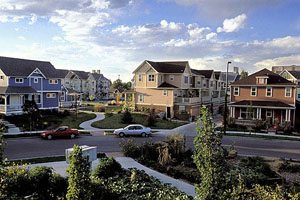
Image Credit: Scott Dressel / Courtesy of the Jonathan Rose Companies
When it convened in Denver last week, the Congress for the New Urbanism’s 17th Annual Congress had a couple of local, working examples of new urbanism to tout: downtown Denver’s trendily revitalized Larimer Square and the decade-old mixed-use community called Highlands’ Garden Village, about 10 minutes north of the city.
Perry Rose LLC, the developer of Highlands’ Garden Village, echoed Congress for New Urbanism’s praise for the project, which embraced many New Urbanism principles such as neighborhood diversity, abundant use of open space, pedestrian-friendly design, context-appropriate architecture, and green construction.
As the developer points out, because the 30-acre site had been rezoned as a planned unit development, its architects and planners were able to apply a fair amount of creativity in balancing open-space, residential, commercial, and other uses.
A 20th-century entertainment center
The site had a colorful evolution, though, well before it became Highlands’ Garden Village. In the 1890s, the property was owned by John and Mary Elitch, who opened a zoological and botanical garden. Amusement park rides were added in 1916, and the gardens’ other entertainment amenities, including a ballroom and the Elitch Theater, attracted a wide following and big-name performers. The amusement park’s owners requested redevelopment proposals for the 30-acre site after the park was closed in 1994.
Garden Village now has 306 residential units (including single-family homes, townhouses, carriage houses, senior independent living, market rate and affordable apartments, and live-work lofts), 75,000 sq. ft. of commercial space (including a 28,000-sq.-ft. health food store, a green cleaner, and offices for doctors, dentists, chiropractors, and optometrists).
Underpinning this construction, the developer says, was a commitment to green practices that included use of recycled materials, low-VOC products, and water-conserving native plants. Wind turbines generate power for all community buildings and site lighting. And the food store, Sunflower supermarket, is one of the first in the world to earn a LEED for Core & Shell Gold rating.
Weekly Newsletter
Get building science and energy efficiency advice, plus special offers, in your inbox.














0 Comments
Log in or create an account to post a comment.
Sign up Log in